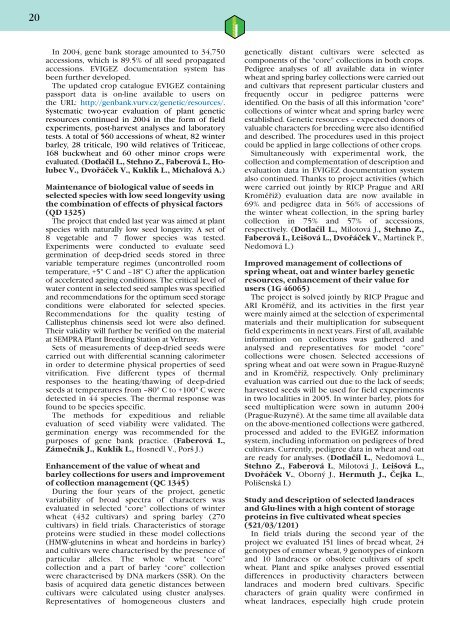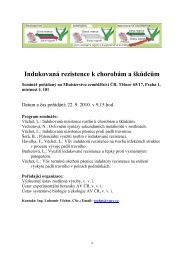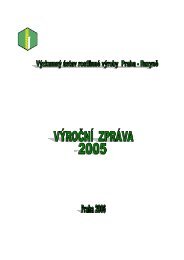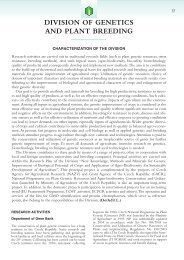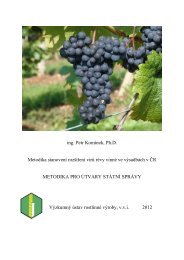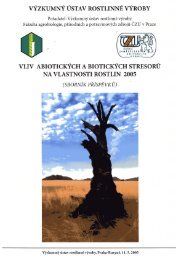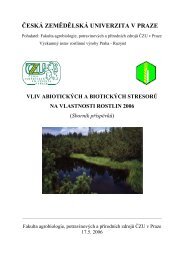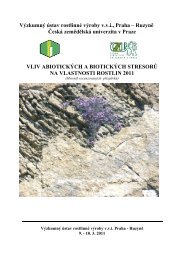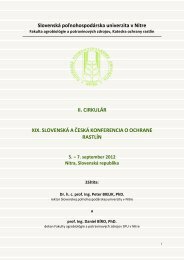Create successful ePaper yourself
Turn your PDF publications into a flip-book with our unique Google optimized e-Paper software.
20In 2004, gene bank storage amounted to 34,750accessions, which is 89.5% of all seed propagatedaccessions. EVIGEZ documentation system hasbeen further developed.The updated crop catalogue EVIGEZ containingpassport data is on-line available to users onthe URL: http://genbank.vurv.cz/genetic/resources/.Systematic two-year evaluation of plant geneticresources continued in 2004 in the form of fieldexperiments, post-harvest analyses and laboratorytests. A total of 560 accessions of wheat, 82 winterbarley, 28 triticale, 190 wild relatives of Triticeae,168 buckwheat and 60 other minor crops wereevaluated. (Dotlačil L., Stehno Z., Faberová I., HolubecV., Dvořáček V., Kuklík L., Michalová A.)Maintenance of biological value of seeds inselected species with low seed longevity usingthe combination of effects of physical factors(QD 1325)The project that ended last year was aimed at plantspecies with naturally low seed longevity. A set of8 vegetable and 7 flower species was tested.Experiments were conducted to evaluate seedgermination of deep-dried seeds stored in threevariable temperature regimes (uncontrolled roomtemperature, +5° C and –18° C) after the applicationof accelerated ageing conditions. The critical level ofwater content in selected seed samples was specifiedand recommendations for the optimum seed storageconditions were elaborated for selected species.Recommendations for the quality testing ofCallistephus chinensis seed lot were also defined.Their validity will further be verified on the materialat SEMPRA Plant Breeding Station at Veltrusy.Sets of measurements of deep-dried seeds werecarried out with differential scanning calorimeterin order to determine physical properties of seedvitrification. Five different types of thermalresponses to the heating/thawing of deep-driedseeds at temperatures from –80° C to +100° C weredetected in 44 species. The thermal response wasfound to be species specific.The methods for expeditious and reliableevaluation of seed viability were validated. Thegermination energy was recommended for thepurposes of gene bank practice. (Faberová I.,Zámečník J., Kuklík L., Hosnedl V., Porš J.)Enhancement of the value of wheat andbarley collections for users and improvementof collection management (QC 1345)During the four years of the project, geneticvariability of broad spectra of characters wasevaluated in selected “core” collections of winterwheat (432 cultivars) and spring barley (270cultivars) in field trials. Characteristics of storageproteins were studied in these model collections(HMW-glutenins in wheat and hordeins in barley)and cultivars were characterised by the presence ofparticular alleles. The whole wheat “core”collection and a part of barley “core” collectionwere characterised by DNA markers (SSR). On thebasis of acquired data genetic distances betweencultivars were calculated using cluster analyses.Representatives of homogeneous clusters andgenetically distant cultivars were selected ascomponents of the “core” collections in both crops.Pedigree analyses of all available data in winterwheat and spring barley collections were carried outand cultivars that represent particular clusters andfrequently occur in pedigree patterns wereidentified. On the basis of all this information "core"collections of winter wheat and spring barley wereestablished. Genetic resources – expected donors ofvaluable characters for breeding were also identifiedand described. The procedures used in this projectcould be applied in large collections of other crops.Simultaneously with experimental work, thecollection and complementation of description andevaluation data in EVIGEZ documentation systemalso continued. Thanks to project activities (whichwere carried out jointly by RICP Prague and ARIKroměříž) evaluation data are now available in69% and pedigree data in 56% of accessions ofthe winter wheat collection, in the spring barleycollection in 75% and 57% of accessions,respectively. (Dotlačil L., Milotová J., Stehno Z.,Faberová I., Leišová L., Dvořáček V., Martinek P.,Nedomová L.)Improved management of collections ofspring wheat, oat and winter barley geneticresources, enhancement of their value forusers (1G 46065)The project is solved jointly by RICP Prague andARI Kroměříž, and its activities in the first yearwere mainly aimed at the selection of experimentalmaterials and their multiplication for subsequentfield experiments in next years. First of all, availableinformation on collections was gathered andanalysed and representatives for model “core”collections were chosen. Selected accessions ofspring wheat and oat were sown in Prague-Ruzyněand in Kroměříž, respectively. Only preliminaryevaluation was carried out due to the lack of seeds;harvested seeds will be used for field experimentsin two localities in 2005. In winter barley, plots forseed multiplication were sown in autumn 2004(Prague-Ruzyně). At the same time all available dataon the above-mentioned collections were gathered,processed and added to the EVIGEZ informationsystem, including information on pedigrees of bredcultivars. Currently, pedigree data in wheat and oatare ready for analyses. (Dotlačil L., Nedomová L.,Stehno Z., Faberová I., Milotová J., Leišová L.,Dvořáček V., Oborný J., Hermuth J., Čejka L.,Polišenská I.)Study and description of selected landracesand Glu-lines with a high content of storageproteins in five cultivated wheat species(521/03/1201)In field trials during the second year of theproject we evaluated 151 lines of bread wheat, 24genotypes of emmer wheat, 9 genotypes of einkornand 10 landraces or obsolete cultivars of speltwheat. Plant and spike analyses proved essentialdifferences in productivity characters betweenlandraces and modern bred cultivars. Specificcharacters of grain quality were confirmed inwheat landraces, especially high crude protein


